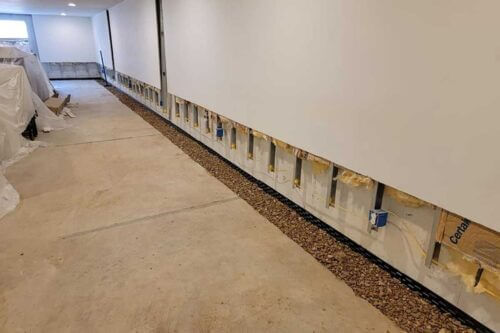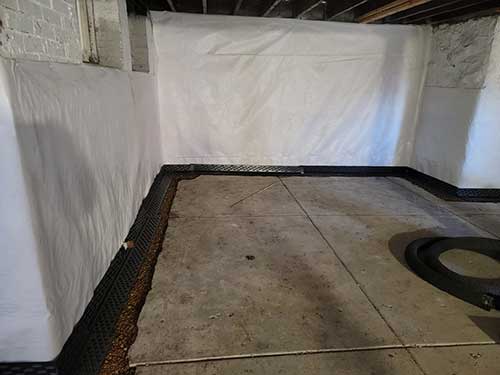
Basement waterproofing is essential for protecting your home’s foundation, indoor air quality, and overall structural integrity. However, there are many basement waterproofing myths that cause confusion and lead homeowners to delay necessary repairs. At Cornerstone Structural Repair & Waterproofing, we want to set the record straight by debunking some of the most common misconceptions about basement waterproofing.
To learn more about these common myths and request a basement waterproofing quote for your project, contact the experts at Cornerstone Structural Repair & Waterproofing today.
Myth #1: Basements Are Supposed to Be Damp
Fact: A Dry Basement Should Be the Standard
Many homeowners believe that some level of dampness in the basement is normal and unavoidable. However, this is a common basement waterproofing myth or misconception. While basements are naturally cooler and more prone to humidity, persistent moisture is a sign of an underlying problem. Whether it’s groundwater seepage, poor drainage, or foundation cracks, basement waterproofing solutions can eliminate basement dampness and protect your home from mold, structural damage, and health hazards.
Myth #2: Waterproofing Paint or Sealant Is Enough
Fact: Waterproofing Requires a Comprehensive Approach
Some homeowners attempt to solve moisture problems by applying waterproofing paint or sealant on their basement walls. While these products can provide a temporary barrier, they do not address the root cause of basement leaks. Moisture can still enter through the foundation, floor, or hydrostatic pressure. A true waterproofing solution often includes drainage systems, sump pumps, and exterior waterproofing to provide long-term protection.
Myth #3: Only Old Homes Need Basement Waterproofing
Fact: Even New Homes Can Have Water Issues
While older homes are more prone to water damage due to aging foundations and outdated drainage systems, new homes are not immune to waterproofing issues. Improper grading, poor construction, and high water tables can lead to water intrusion in basements, regardless of a home’s age. Proactive waterproofing measures can prevent costly repairs down the line.
Myth #4: A Small Crack in the Foundation Is Nothing to Worry About
Fact: Small Cracks Can Lead to Big Problems
Foundation cracks, even small ones, can allow water to seep into your basement. Over time, these cracks can widen, leading to structural issues and increased moisture problems. Professional foundation crack repair and waterproofing can prevent minor cracks from becoming major structural threats.
Myth #5: Basement Waterproofing Is Too Expensive
Fact: Waterproofing Is a Smart Investment That Saves Money Over Time
This is another common basement waterproofing myth. While basement waterproofing does come with an upfront cost, the long-term benefits far outweigh the initial expense. Without proper waterproofing, homeowners may face costly repairs due to mold remediation, foundation damage, and ruined belongings. Many professional waterproofing companies, including Cornerstone Structural Repair & Waterproofing, offer financing options to make basement waterproofing costs and solutions more affordable.
Myth #6: A Sump Pump Is All You Need for a Dry Basement
Fact: A Sump Pump Is Helpful but Not a Complete Solution
Sump pumps to are an important part of many waterproofing systems, but they are not a standalone solution. A comprehensive waterproofing approach should also include proper drainage systems, exterior waterproofing, and foundation sealing to ensure complete moisture control.
Myth #7: DIY Waterproofing Is Just as Effective as Professional Services
Fact: DIY Solutions Often Provide Temporary Fixes
Some homeowners attempt to waterproof their basements using DIY methods like caulking cracks or installing dehumidifiers. While these solutions may help reduce minor moisture issues, they do not provide the same level of protection as professional waterproofing. Experts can diagnose the root cause of water intrusion and implement lasting solutions tailored to your home’s needs.

FAQs About Basement Waterproofing
How do I know if my basement needs waterproofing?
If you notice musty odors, visible water stains, mold growth, or foundation cracks, it’s time to consider waterproofing solutions. Even if you don’t see standing water, excessive humidity and dampness are warning signs.
What is the best method for waterproofing a basement?
The best method depends on the specific cause of moisture issues. Solutions may include interior drainage systems, sump pumps, exterior waterproofing membranes, and foundation crack repairs.
Does basement waterproofing increase home value?
Yes, a waterproofed basement adds to a home’s value by preventing structural damage and creating a healthier, more usable space. Buyers are more likely to invest in a home with a dry, well-maintained basement.
How long does basement waterproofing last?
When professionally installed, waterproofing solutions can last for decades. At Cornerstone Structural Repair & Waterproofing, we back our work with a life-of-structure warranty to give homeowners peace of mind.
Contact Us for Professional Basement Waterproofing in St. Louis
Don’t let basement waterproofing myths prevent you from protecting your home. If you suspect moisture problems in your basement, Cornerstone Structural Repair & Waterproofing is here to help. Our experienced team offers comprehensive waterproofing solutions backed by our life-of-structure foundation repair warranty.
Call us today or contact us online to schedule a free inspection and keep your basement dry for years to come!

